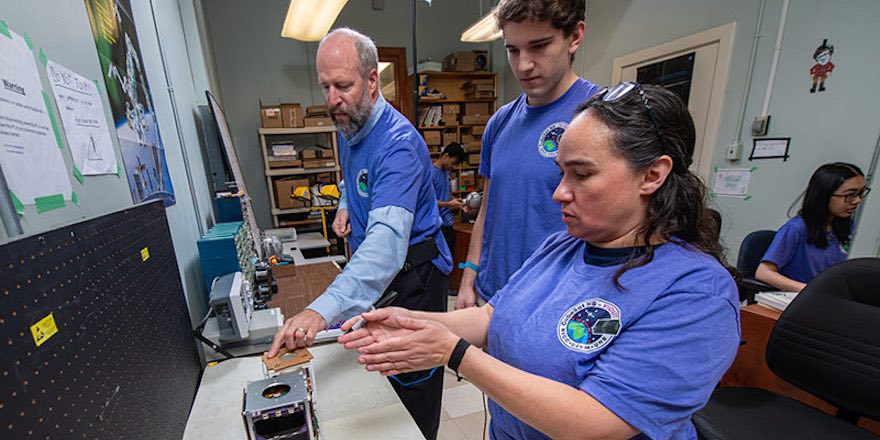UNB Launching the Province’s First Satellite into Orbit
UNB students get chance of a lifetime working on New Brunswick's first satellite.

New Brunswick is one step closer to launching its first satellite into space, thanks to over five years of work from more than 270 students from the University of New Brunswick and elsewhere. “They did a fantastic job with this Canadian CubeSat project,” said Brent Petersen, professor of electrical and computer engineering, who helped spearhead the initiative at UNB.
Named VIOLET after the provincial flower, the breadbox-sized satellite is a joint effort between UNB, the Université de Moncton, and New Brunswick Community College. It’s a part of the larger Canadian CubeSat project, which saw 15 educational institutions across the country create their own satellites.
VIOLET had a brief moment in the sun on November 21, when it had public viewing at Head Hall before heading to the Canadian Space Agency in Montreal in preparation for a March launch from the Kennedy Space Center in Florida.
Learning about the atmosphere through VIOLET
Once deployed from the International Space Station, VIOLET will begin its even longer moment in the sun — orbiting Earth for anywhere from three months to two years. VIOLET will deliver information about the upper atmosphere including the ionosphere, the uppermost part of Earth’s atmosphere, where ultraviolet light and x-ray solar radiation cause electrons to pop free of their atomic and molecular bonds leaving ions behind.
Richard Langley, a geodesy and geomatics engineering professor, says VIOLET will be perfectly positioned to study the 11-year sunspot cycle, which is reaching its peak. Energetic particles emitted from the sun intensify during this period, making the upper atmosphere thicker and providing a wealth of information about the relationship between it and the sun’s activity.
“The satellite will de-orbit faster, the more atoms and molecules that it’s running into,” Langley says of VIOLET’s journey through the atmosphere before disintegrating as it falls back to earth.
“We can learn something about what the atmosphere is doing just by following the motion of the satellite.” Oriented along the earth’s magnetic field by a magnet at its centre, VIOLET’s four sets of solar panels will capture light variations. “When we look at the illumination on the solar panels, we’ll get a sense of the dynamics of the satellite,” Langley said.
The team hopes the timing will be right for a special observation over New Brunswick in the new year.
“We would like VIOLET to be in orbit about a week before April 8 because that’s the solar eclipse over New Brunswick,” Petersen says, noting that he’ll be asking CSA and NASA if that will be possible.
Honouring the commitment to work with Indigenous people
VIOLET will not only be gathering data but also carrying a special message for New Brunswickers of Indigenous descent. Cheyenne Joseph, Piluwitahasuwin Associate Vice President of Indigenous Engagement, inscribed VIOLET with a Mi'kmaw hieroglyph.
“It means ‘the people,’” Joseph says of the looping symbol resting on the top of VIOLET’s rectangular structure. Joseph says she was happy to add the inscription at the request of the CubeSat team.
“Knowing that the satellite’s going over the province…this is one way to honour that commitment to work with Indigenous people. It’s a way to leave our mark and to be included.”
Students gain valuable experience working on satellite
Samiha Lubaba is an electrical engineering master’s student who started working on the CubeSat project this past summer. “I’m working on the ground station communications,” she said. “I’m going to be communicating with VIOLET to make sure it’s working fine up in space.” Her work will involve transmitting information ‘packets’ to and from the satellite using the two large antennas the team set up on the roof of Gillin Hall.
Using Ham Radio Deluxe software, the VIOLET team will communicate with the satellite as it makes its numerous passes through the sky, some directly overhead and some just peeking over the horizon. The team estimates it will get about 30 minutes of communication with the satellite daily.
The students, like Lubaba at the ground station, will manipulate the antenna's movement from the building's control room. An azimuth-elevation rotator track will allow the equipment to rotate and tilt to align with the satellite no matter where it is in the sky above.
Langley says for now, the plan is that the UNB station will be the only one actively communicating with VIOLET, but that the door is still open to working with a network of other ground stations across the country and even around the world, to collect VIOLET’s data.
“The ground station is almost a separate project that students can use to track other kinds of satellites. Even weather satellites or other science satellites,” said Langley. “That exposes them to even more aerospace technology.”
As one of the students delivering VIOLET to the Canadian Space Agency in Montreal, Lubaba is excited for the March launch. “It’s a career-transforming project for me,” she said. “I’m really proud because it’s New Brunswick’s first satellite and I’m a part of it.”
Learn more about the University of New Brunswick
